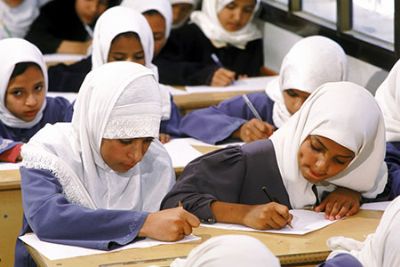- • 56% of primary school students cannot read or write fluently or perform basic numeracy functions. 48% of secondary school students cannot perform these basics. In the words of the report: "More than half of the region's children and youth are failing to learn, as measured by literacy and numeracy scores on international tests."
• "When looking at the totality of children throughout the Arab world who are out of school, expected to drop out, or are not learning while in school, one sees a bleak picture and a crisis of significant proportions. For the five countries for which we have complete data, we find that nearly half or more of all primary-aged children are not learning. The situation is par¬ticularly critical in Yemen, where close to 95 percent of all primary children are not learning."
• Only 50% of Djibouti children are even enrolled in primary school
• Arab World Learning Barometer: percentage of students not meeting basic learning level, 2011/12, Primary: 40% of children in Saudi Arabia who attend primary school are not learning; 76.5% of children in Morocco; 91% of children in Yemen; 54% of children in Oman; 36% of children in UAE, 42.5% of children in Qatar, 70% of children in Kuwait, 65% of children in Tunisia. The share of boys in school that do not meet basic learning levels is higher than girls.
• Total Learning Deficit (are out of school, expected to drop out, or are not learning while in school) for the 5 states where the information is available: Yemen 84.5%, Morocco 79.4%, Tunisia 67%, Saudi Arabia 48.9%, Qatar 48.1%.
• "Education data for the Arab states are incredibly scarce. Of the 20 states in the Arab world, 3-Iraq, Libya and Sudan-have no recent data available for primary or lower secondary school enrollment, school survival (i.e., completion), out-of-school populations or learning outcomes...Only 2 countries-Qatar and the United Arab Emirates-test students at both levels for both numeracy and literacy."
• The Arab region has the lowest female participation rate in the labor force in the world: 24.1% female participation (2008-1011). In Saudi Arabia: male youth unemployment is 23.5%, female 55%. In Egypt, male youth unemployment is 14.7%, female 54%. In Algeria male youth unemployment is 18.7%, female 37.6%. The Arab countries with the lowest rates of employing young women are: Saudi Arabia (7% of girls participate in labor force), Iraq (8.1%), Syria (9.2%) and Algeria (8.9%). "Labor force participation is particularly low for women, with an average of 24.1% compared with 77.2% for men. The low female participation rate, together with high unemployment, means that only about 18 percent of working-age Arab women actually have jobs."

